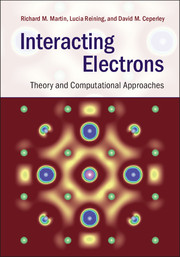Book contents
- Frontmatter
- Dedication
- Contents
- Preface
- Acknowledgments
- Notation
- Part I Interacting electrons: beyond the independent-particle picture
- 1 The many-electron problem: introduction
- 2 Signatures of electron correlation
- 3 Concepts and models for interacting electrons
- Part II Foundations of theory for many-body systems
- Part III Many-body Green's function methods
- Part IV Stochastic methods
- Part V Appendices
- References
- Index
3 - Concepts and models for interacting electrons
from Part I - Interacting electrons: beyond the independent-particle picture
Published online by Cambridge University Press: 05 June 2016
- Frontmatter
- Dedication
- Contents
- Preface
- Acknowledgments
- Notation
- Part I Interacting electrons: beyond the independent-particle picture
- 1 The many-electron problem: introduction
- 2 Signatures of electron correlation
- 3 Concepts and models for interacting electrons
- Part II Foundations of theory for many-body systems
- Part III Many-body Green's function methods
- Part IV Stochastic methods
- Part V Appendices
- References
- Index
Summary
The art of being wise is the art of knowing what to overlook.
William JamesSummary
This chapter is devoted to idealized models and theoretical concepts that underlie the topics in the rest of this book. Among the most dramatic effects are the Wigner and Mott transitions, exemplified by electrons in a homogeneous background of positive charge and by the Hubbard model of a crystal. Fermi liquid theory is the paradigm for understanding quasi-particles and collective excitations in metals, building on a continuous link between a non-interacting and an interacting system. The Luttinger theorem and Friedel sum rule are conservation laws for quantities that do not vary at all with the interaction. The Heisenberg and Ising models exemplify the properties of localized electronic states that act as spins. The Anderson impurity model is the paradigm for understanding local moment behavior and is used directly in dynamical mean-field theory.
The previous chapters discuss examples of experimental observations where effects of interactions can be appreciated with only basic knowledge of physics and chemistry. The purpose of this chapter is to give a concise discussion of models that illustrate major characteristics of interacting electrons. These are prototypes that bring out features that occur in real problems, such as the examples in the previous chapter. They are also pedagogical examples for the theoretical methods developed later, with references to specific sections.
The Wigner transition and the homogeneous electron system
The simplest model of interacting electrons in condensed matter is the homogeneous electron system, also called homogeneous electron gas (HEG), an infinite system of electrons with a uniform compensating positive charge background. It was originally introduced as a model for alkali metals. Now the HEG is a standard model system for the development of density functionals and a widely used test system for the many-body perturbation methods in Chs. 10–15. It is also an important model for quantum Monte Carlo calculations, described in Chs. 23–25.
To define the model, we take the hamiltonian in Eq. (1.1) and replace the nuclei by a rigid uniform positive charge with density equal to the electron charge density n.
Information
- Type
- Chapter
- Information
- Interacting ElectronsTheory and Computational Approaches, pp. 40 - 58Publisher: Cambridge University PressPrint publication year: 2016
